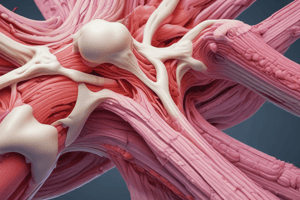Podcast
Questions and Answers
What is the perimysium?
What is the perimysium?
The sheath of connective tissue surrounding a bundle of muscle fibers.
What does epimysium refer to?
What does epimysium refer to?
A sheath of fibrous elastic tissue surrounding a muscle.
What is the function of endomysium?
What is the function of endomysium?
It is a wispy layer of areolar connective tissue that ensheaths each individual myocyte.
What is a tendon?
What is a tendon?
Define sarcolemma.
Define sarcolemma.
What are transverse tubules?
What are transverse tubules?
What is sarcoplasm?
What is sarcoplasm?
What does sarcoplasmic reticulum do?
What does sarcoplasmic reticulum do?
What is a sarcomere?
What is a sarcomere?
What are myofibrils?
What are myofibrils?
Define myofilament.
Define myofilament.
What is a Z disc?
What is a Z disc?
What does A band refer to?
What does A band refer to?
What is an I band?
What is an I band?
What is the H zone?
What is the H zone?
What does M line signify?
What does M line signify?
What is actin?
What is actin?
What is myosin?
What is myosin?
Define muscle fiber.
Define muscle fiber.
What is a neuromuscular junction?
What is a neuromuscular junction?
What does synapse mean?
What does synapse mean?
What is a motor end plate?
What is a motor end plate?
What is a twitch?
What is a twitch?
What is unfused tetanus?
What is unfused tetanus?
What is fused tetanus?
What is fused tetanus?
Define isotonic contraction.
Define isotonic contraction.
What is isometric contraction?
What is isometric contraction?
Flashcards are hidden until you start studying
Study Notes
Muscle Tissue and Associated Structures
- Perimysium: Connective tissue sheath surrounding muscle fiber bundles.
- Epimysium: Fibrous elastic tissue encasing an entire muscle.
- Endomysium: Areolar connective tissue layer surrounding individual muscle fibers, housing capillaries and nerves, overlaying the sarcolemma (muscle cell membrane).
- Tendon: Strong, flexible cord of collagen connecting muscle to bone.
- Sarcolemma: Transparent tubular sheath enveloping skeletal muscle fibers.
- Transverse tubules: Extensions of cell membrane that delve into the center of skeletal and cardiac muscle cells.
- Sarcoplasm: Cytoplasm specific to striated muscle cells.
- Sarcoplasmic reticulum: Organelle responsible for calcium storage within muscle fibers.
Muscle Fiber Structure
- Sarcomere: Functional contractile unit of a muscle.
- Myofibril: Dense bundles of filaments situated within skeletal muscle fibers.
- Myofilament: Structures containing actin or myosin proteins.
- Z disc: Protein sheet anchoring thin filaments and linking myofibrils.
- A band: Dark region extending the length of thick filaments.
- I band: Lighter band present in the sarcomere.
- H zone: Area containing only thick filaments.
- M line: Central line of the sarcomere.
Muscle Contraction Proteins
- Actin: Globular protein forming chains that create microfilaments necessary for muscle contraction.
- Myosin: Major protein in muscle fibers that facilitates contraction.
Muscle Fiber Functions
- Muscle fiber: A single muscle cell responsible for contraction.
- Neuromuscular junction: Connection point where a motor neuron interacts with a skeletal muscle cell.
- Synapse: Junction between the axon of one neuron and the receiving neuron’s dendrite or cell body.
- Motor end plate: Flattened end of a motor neuron facilitating neural impulse transmission to muscle.
Muscle Contraction Mechanics
- Twitch: Series of events resulting from a single stimulus in a muscle fiber, followed by contraction and relaxation.
- Unfused tetanus: Partial relaxation occurring between muscle twitches during wave summation.
- Fused tetanus: Sustained contraction with no relaxation due to high stimulus frequency.
- Isotonic contraction: Muscle shortens as tension exceeds the load.
- Isometric contraction: Muscle tension generates without changing length, resulting in no movement.
Studying That Suits You
Use AI to generate personalized quizzes and flashcards to suit your learning preferences.


